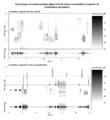Thrush nightingale facts for kids
The thrush nightingale (Luscinia luscinia) is a small bird found in parts of Europe and Asia. It's famous for its powerful and varied song, especially at night. While it used to be grouped with thrushes, scientists now consider it a type of Old World flycatcher. These birds are known for catching insects in the air.
Contents
About the Thrush Nightingale
The thrush nightingale is a fascinating bird, often heard more than seen. It's a shy bird that prefers to stay hidden in dense bushes and trees. Its scientific name, Luscinia luscinia, comes from Latin words related to singing.
What It Looks Like
This bird is quite plain, which helps it blend into its surroundings. It's about the size of a sparrow, around 16 centimeters (6 inches) long. Its feathers are mostly brown on top, with a slightly paler, grayish-brown belly. It has a short tail and a small, dark beak. Young thrush nightingales look similar to adults but might have a slightly spotted appearance.
Where It Lives
Thrush nightingales prefer damp, dense areas. You can find them in thickets, woodlands, and areas with lots of undergrowth, especially near water. They are common in central and eastern Europe, and across parts of Asia. During the breeding season, they stay in these northern areas.
Its Amazing Song
The thrush nightingale is best known for its loud and rich song. Both male and female birds sing, but the male's song is especially powerful and complex. They often sing at night, which is why they are called "nightingales." Their song includes a mix of whistles, trills, and deep, frog-like croaks. Each song can be very long and varied, making it one of the most impressive bird songs in the world. They use their song to attract mates and to mark their territory.
Life Cycle and Migration
Thrush nightingales are migratory birds. This means they travel long distances between their breeding grounds and their winter homes. After breeding in Europe and Asia during the spring and summer, they fly south to spend the winter in eastern and southern Africa. This journey is thousands of miles long!
When they return in spring, they build their nests close to the ground, often hidden in dense vegetation. The female usually lays 4 to 6 eggs, which are a greenish-blue color. Both parents help to feed the young chicks until they are ready to leave the nest. The young birds grow quickly and are ready to fly and find their own food in just a few weeks.
Images for kids
See also
 In Spanish: Ruiseñor ruso para niños
In Spanish: Ruiseñor ruso para niños




